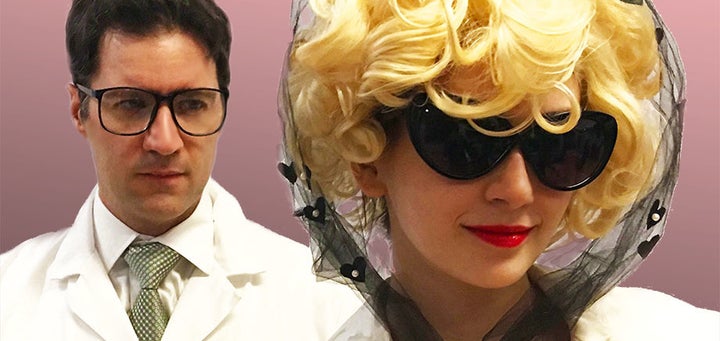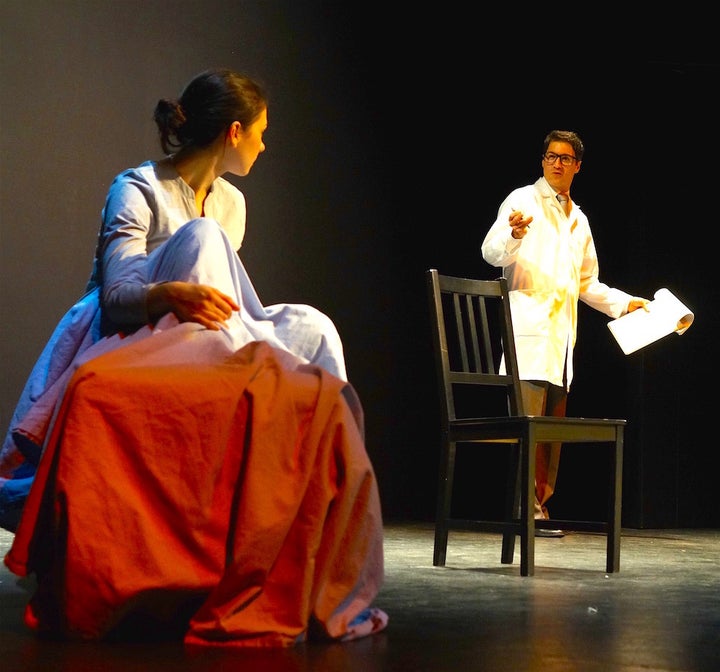
Can we ever get enough Marilyn Monroe? Apparently, given the fascination that the world has had for the actress through the years, the answer is definitely “No!” The woman who was born Norma Jeane Mortenson in 1926 would go on to become the world’s ultimate blonde bombshell, the larger-than-life legend who cemented her status in pop culture forever. Marilyn would remain an object of desire and fascination for decades, even after her death in 1962. As one of our most enduring sex symbols and cinematic icons, she’s been worshiped, imitated, studied, analyzed, and exploited. The public’s love affair with the glamorous star is unlikely to disappear anytime in the next few decades.
N.G. McClernan’s new play, Norma Jeane at The Payne Whitney Psychiatric Clinic, which enjoyed its world premiere at New York City’s Hudson Guild Theater, boldly re-creates a scenario which explores a distinctly UNglamorous time in Marilyn’s turbulent life. The play is indeed based on fact: After Monroe’s divorce from third husband Arthur Miller in January of 1961, the star was involuntarily committed to the famous New York City sanitarium by her psychiatrist, Marianne Kris, to “get some rest”. A six-page letter from Marilyn to another psychiatrist, Ralph Greenson, was made public in 2015. The letter, dated March 1, 1961, detailed some genuine horrors. That included verbal and mental abuse by a cruel doctor, and Marilyn desperately throwing a chair into a glass window― an idea which she got from her movie Don’t Bother to Knock. It’s also a well-documented fact that her ex-husband and lifelong supporter Joe DiMaggio did threaten to “tear the hospital down, brick by brick” and ruin the institution’s reputation if Marilyn wasn’t released― which, of course, she eventually was.

Those episodes are included in McClernan’s play, which opens to a stark, depressing set appropriately replicating the stark, depressing cell where Monroe was ostensibly held, under the pseudonym “Mary Miller”. The audience hears other patients screaming and crying in the background. Barefoot, wearing a bland pajamas-like top and bottom set, and without her Monroe-esque makeup or hairstyle, the actress (played by Jenna Sanders), is forced to confront her own conflicted identity: the vulnerable Norma Jeane (”the girl who nobody wanted”) versus the “Marilyn” that she’d become (”the girl who everyone wanted, but who’s name was unknown to me at the time”). When she’s not sparring with her alternately sadistic and masochistic, closeted gay doctor Mark Lewis (Matthew DeCapua)― who calls Monroe “a very sick girl”, “a drug addict”, “a rapidly aging actress”, and worse― the isolated star speaks directly to the audience about a wide variety of subjects: her difficult childhood, her budding sexuality, and how she learned to use that sexuality to become a star. Sadly, her image as a sex goddess turned out to become something of an albatross: Monroe wanted to be taken seriously as an actress, rather than to be― in her own words― an “erotic freak”. Sander-as-Marilyn also speaks provocatively about her disappointment with the people in her life: mostly the powerful and/or influential men who came in and out of her world. They included DiMaggio, Miller, Michael Chekhov, and Lee Strasberg― all of them also played by DeCapua. In particular, she viewed ex-hubby Arthur Miller’s treatment of her as a betrayal― particularly with his involvement in her last completed movie The Misfits. Via Sander’s portrayal, Norma Jeane/Marilyn comes across not as “crazy” (as her doctor would like her to believe) or, despite her image on the movie screen, as “dumb”―but instead, Monroe was likely high-strung, aching to be understood, frustrated, and restless. The Marilyn Monroe in THIS play can also hold her own, especially when she spits a pill back at her doctor, or hits back at her tormentor with some teasing of her own (”You let me out of here, and I won’t tell anyone your ‘secret’!”) I won’t give away anything that’s not already part of Marilyn Monroe lore, but let’s just say that, believe it or not, there IS a gay ending (”gay” as in “happy” as well as the modern-day meaning...)
The performances by Sander and DeCapua are excellent. Although Sander has Monroe’s heart-shaped face, bedroom eyes, and sensual mouth, audiences may find it off-putting that the world’s most famous blonde is portrayed by a brunette actress. This may be the intent of the director, whose interpretation of the star in this play is closer to the plain, brown-haired Norma Jeane rather than the glamorous, platinum-haired Marilyn. Still, Marilyn would have definitely been blonde at this point in her life, and her not being so for almost all of the play requires some suspension of disbelief from the audience. In addition, Marilyn was also 34 at this time of her institutionalization, and Sander looks about 20 years old― which makes the doctor’s merciless barbs about Marilyn “getting old” a bit hard to swallow. Still, Sander bravely has her own unique take on the Norma Jeane/Marilyn persona, and both writer/director McClernan and Sander both deserve credit for avoiding the larger-than-life, often cliched “Monroe-isms” that have been done so often by Marilyn’s many imitators, including drag artists. Both Norma Jeane and Marilyn, who struggled with their co-existing personas for so long, would have both no doubt appreciated that.
Norma Jeane at The Payne Whitney Psychiatric Clinic is part The 2017 NY Winterfest. Visit www.Mergatroyd.org/NormaJeane to stay abreast of future dates.
